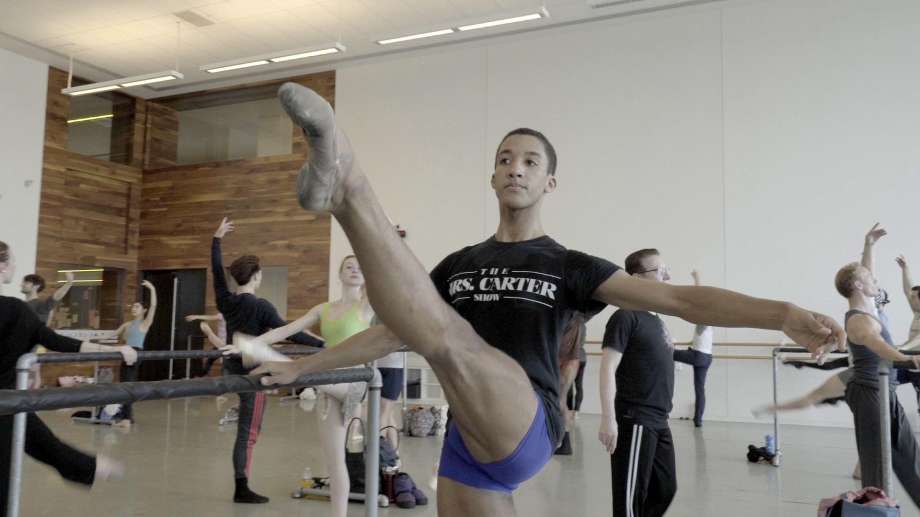June 22, 2018 Updated: June 22, 2018 2:23pm
Sexism is built into the fabric of classical ballet, an art form that has always idolized women in toe shoes and tutus while relegating men to the role of partners, at least until the rare superstar emerges.
Way back in the 20th century, Mikhail Baryshnikov and Rudolf Nureyev were icons. The 21st century hasn’t yet discovered a male ballet star of their magnitude.
Even worse, young men who pursue careers as danseurs, or male ballet dancers, are highly likely to be stigmatized and bullied at school — and home — outcasts in a society that only sees ballet as feminine. Never mind that dancers train as hard as the most extreme athletes.
“Danseur,” a new documentary that explores issues facing young men in the ballet world, screens Tuesday evening at Houston Ballet’s Center for Dance. Producer and director Scott Gormley and Houston Ballet soloist Harper Watters, who appears in the film, will give a talk afterward.
“I’ve been told I’m a terrible representative for ballet,” said Watters, who is openly gay. “But I have thick skin. I only use that as a motivation.”
Watters said the stereotype associated with male dancers also affects colleagues who are not gay. But by putting himself out there, he has opened himself up to even more intense derision, bullying and threats.
Gormley, a former advertising industry creative director, initially undertook “Danseur” as a “pure passion project” because he is the father of a young male ballet dancer whose social life changed dramatically in the seventh grade, when buddies he’d had since childhood quit coming to hang out on weekends.
Gormley soon found other parents who saw their boys’ problems, and he felt he had a bigger story to tell after he and screenwriter Russ Mahler interviewed a number of young dancers who told graphic stories of abuse and harassment. “We knew if there were a couple of boys, there were dozens,” he said.
Actually, there are thousands. Doug Risner, a leading dance researcher and a professor at Wayne State University in Detroit, found that 96 percent of men who have studied dance have been targets of teasing, name-calling and other verbal abuse; 70 percent have reported verbal and/or physical harassment; 34 percent have experienced verbal threats or threatening behavior; and 16 percent have reported physical harm or injury.
The bullying and threats come not just from people at school, including coaches, but from parents, siblings and other relatives who may be the least supportive of all.
For some boys, those hurdles are far harder to overcome than the physical demands and years of training it takes to achieve balletic virtuosity and strength. They also outweigh the low salary factor, since male dancers in the U.S., on average, earn $36,000 a year, according to the organization Data USA. (Although they do out-earn women, whose salaries average $29,200.)
Gormley said his son’s issues were not as dramatic as the stories of other boys, and once he entered a performing arts high school, he was encouraged and in his element.
Watters, too, has supportive parents, although as academics — both college English professors — they had to be convinced that quitting a conventional high school to pursue dance was a good idea. Watters is adopted and an only child.
As an African-American, he felt his skin color was his biggest deterrent; that his only option for a career in dance would be with Alvin Ailey American Dance Theater. “That’s where I saw people like me,” he said. “Not that they aren’t great. They are one of my biggest inspirations.”
Watters left home at 14 to attend Walnut Hill School for the Performing Arts in Massachusetts. From there, his friend Joseph Walsh (now a San Francisco Ballet principal) pointed him to Houston, a company widely recognized for its strong men’s coaching program and its history of diversity. It was the home of one of the country’s most high-profile African-American stars, Lauren Anderson; a place that also helped the dark-skinned Cuban Carlos Acosta launch his career.
Gormley, the “Danseur” director, discovered him through social media channels. The crew filmed at Houston Ballet’s studios in 2016, also including Derek Dunn, who now dances with Boston Ballet.
In tandem with the film, Gormley created the NuArts Foundation, a nonprofit devoted to helping young men who want to dance. “I knew the issue was bigger than the movie,” he said. “These boys are going to need help for a long time.”
He hopes to build educational programs and work with middle schools; and NuArts recently sponsored two boys who studied for a few weeks in Australia. His son Jack, now 19, attends Point Park University in Pittsburg and is at the Pittsburgh Ballet Theatre’s school this summer. He does not appear in the film.
“At the end of the day, I didn’t want it to be about him,” Gormley said. “I wanted it to be an issue film.”
Watters, for one, is grateful. “I fight the stereotype because I fit it. That’s something ‘Danseur’ tackles well,” he said. “It’s a really important film.”

